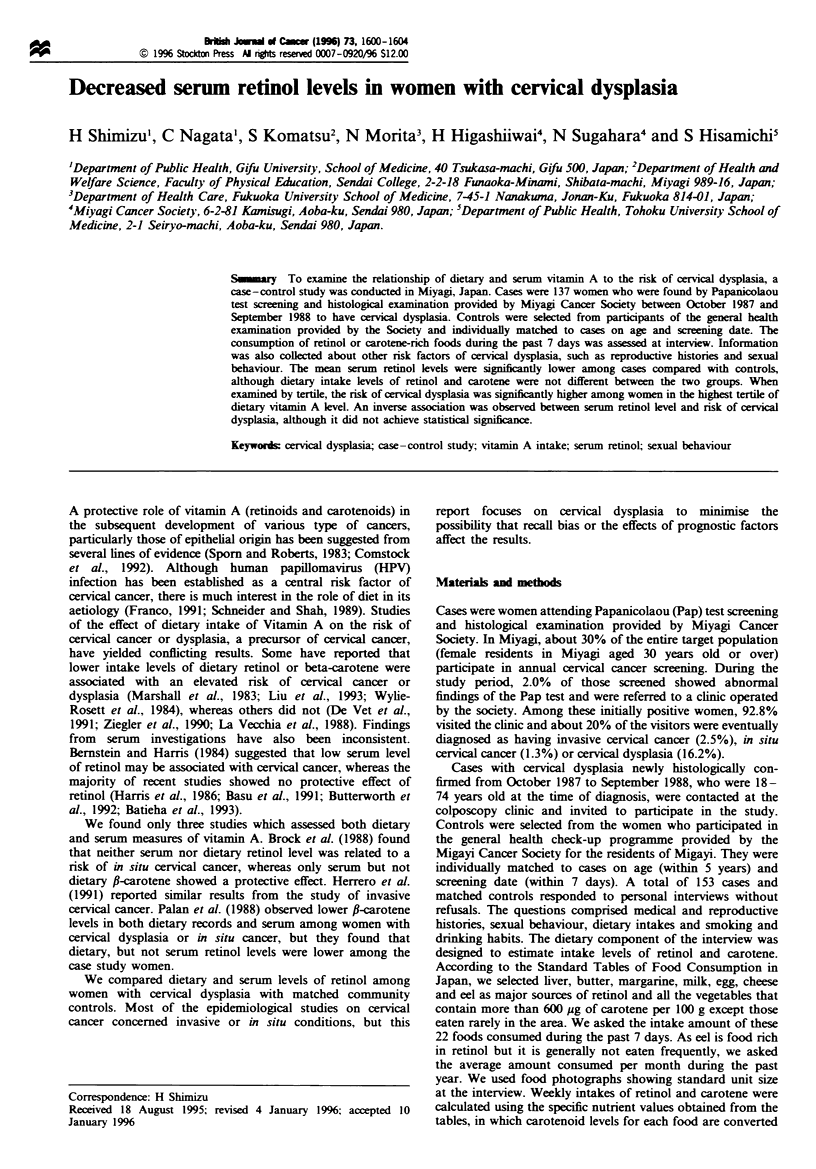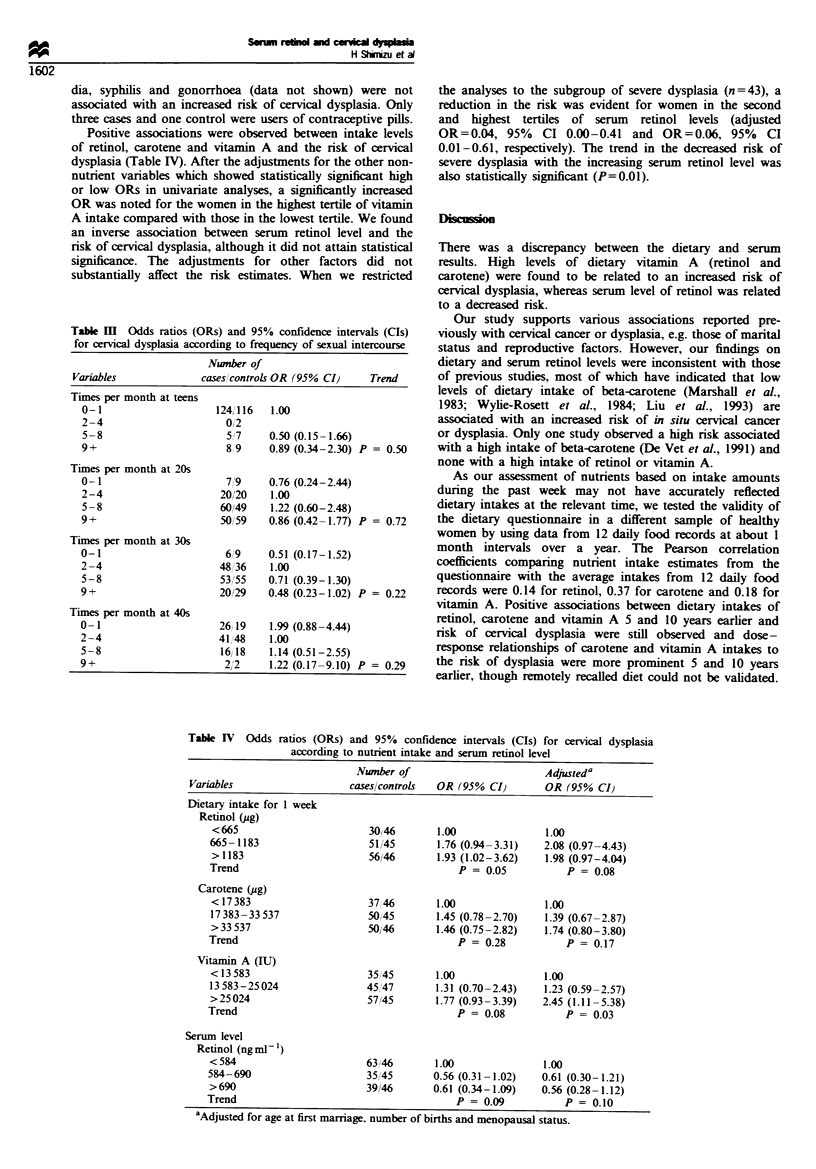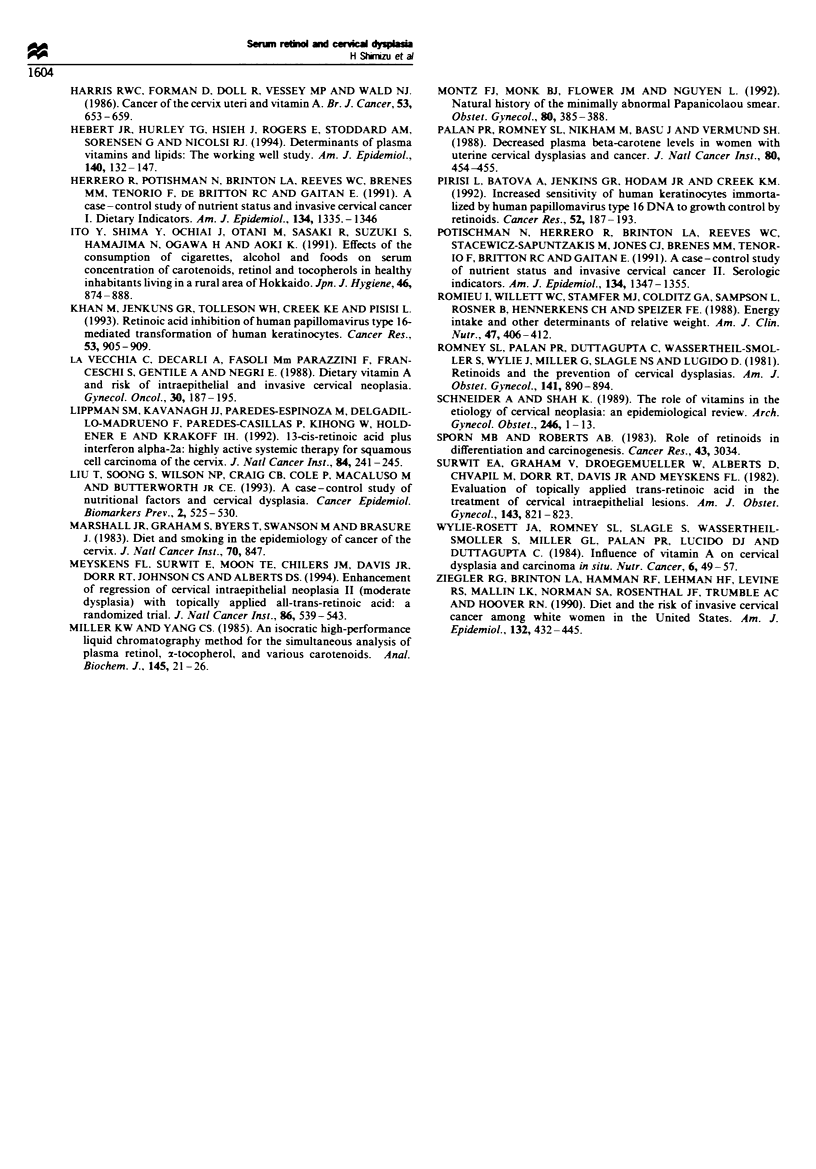Abstract
To examine the relationship of dietary and serum vitamin A to the risk of cervical dysplasia, a case-control study was conducted in Miyagi, Japan. Cases were 137 women who were found by Papanicolaou test screening and histological examination provided by Miyagi Cancer Society between October 1987 and September 1988 to have cervical dysplasia. Controls were selected from participants of the general health examination provided by the Society and individually matched to cases on age and screening date. The consumption of retinol or carotene-rich foods during the past 7 days was assessed at interview. Information was also collected about other risk factors of cervical dysplasia, such as reproductive histories and sexual behaviour. The mean serum retinol levels were significantly lower among cases compared with controls, although dietary intake levels of retinol and carotene were not different between the two groups. When examined by tertile, the risk of cervical dysplasia was significantly higher among women in the highest tertile of dietary vitamin A level. An inverse association was observed between serum retinol level and risk of cervical dysplasia, although it did not achieve statistical significance.
Full text
PDF




Selected References
These references are in PubMed. This may not be the complete list of references from this article.
- Basu J., Palan P. R., Vermund S. H., Goldberg G. L., Burk R. D., Romney S. L. Plasma ascorbic acid and beta-carotene levels in women evaluated for HPV infection, smoking, and cervix dysplasia. Cancer Detect Prev. 1991;15(3):165–170. [PubMed] [Google Scholar]
- Batieha A. M., Armenian H. K., Norkus E. P., Morris J. S., Spate V. E., Comstock G. W. Serum micronutrients and the subsequent risk of cervical cancer in a population-based nested case-control study. Cancer Epidemiol Biomarkers Prev. 1993 Jul-Aug;2(4):335–339. [PubMed] [Google Scholar]
- Bernstein A., Harris B. The relationship of dietary and serum vitamin A to the occurrence of cervical intraepithelial neoplasia in sexually active women. Am J Obstet Gynecol. 1984 Feb 1;148(3):309–312. doi: 10.1016/s0002-9378(84)80074-5. [DOI] [PubMed] [Google Scholar]
- Brock K. E., Berry G., Mock P. A., MacLennan R., Truswell A. S., Brinton L. A. Nutrients in diet and plasma and risk of in situ cervical cancer. J Natl Cancer Inst. 1988 Jun 15;80(8):580–585. doi: 10.1093/jnci/80.8.580. [DOI] [PubMed] [Google Scholar]
- Butterworth C. E., Jr, Hatch K. D., Macaluso M., Cole P., Sauberlich H. E., Soong S. J., Borst M., Baker V. V. Folate deficiency and cervical dysplasia. JAMA. 1992 Jan 22;267(4):528–533. [PubMed] [Google Scholar]
- Comstock G. W., Bush T. L., Helzlsouer K. Serum retinol, beta-carotene, vitamin E, and selenium as related to subsequent cancer of specific sites. Am J Epidemiol. 1992 Jan 15;135(2):115–121. doi: 10.1093/oxfordjournals.aje.a116264. [DOI] [PubMed] [Google Scholar]
- Darwiche N., Celli G., De Luca L. M. Specificity of retinoid receptor gene expression in mouse cervical epithelia. Endocrinology. 1994 May;134(5):2018–2025. doi: 10.1210/endo.134.5.8156902. [DOI] [PubMed] [Google Scholar]
- Darwiche N., Celli G., Sly L., Lancillotti F., De Luca L. M. Retinoid status controls the appearance of reserve cells and keratin expression in mouse cervical epithelium. Cancer Res. 1993 May 15;53(10 Suppl):2287–2299. [PubMed] [Google Scholar]
- Franco E. L. Viral etiology of cervical cancer: a critique of the evidence. Rev Infect Dis. 1991 Nov-Dec;13(6):1195–1206. doi: 10.1093/clinids/13.6.1195. [DOI] [PubMed] [Google Scholar]
- Gorodeski G. I., Eckert R. L., Utian W. H., Sheean L., Rorke E. A. Cultured human ectocervical epithelial cell differentiation is regulated by the combined direct actions of sex steroids, glucocorticoids, and retinoids. J Clin Endocrinol Metab. 1990 Jun;70(6):1624–1630. doi: 10.1210/jcem-70-6-1624. [DOI] [PubMed] [Google Scholar]
- Hallfrisch J., Muller D. C., Singh V. N. Vitamin A and E intakes and plasma concentrations of retinol, beta-carotene, and alpha-tocopherol in men and women of the Baltimore Longitudinal Study of Aging. Am J Clin Nutr. 1994 Aug;60(2):176–182. doi: 10.1093/ajcn/60.2.176. [DOI] [PubMed] [Google Scholar]
- Harris R. W., Forman D., Doll R., Vessey M. P., Wald N. J. Cancer of the cervix uteri and vitamin A. Br J Cancer. 1986 May;53(5):653–659. doi: 10.1038/bjc.1986.109. [DOI] [PMC free article] [PubMed] [Google Scholar]
- Hebert J. R., Hurley T. G., Hsieh J., Rogers E., Stoddard A. M., Sorensen G., Nicolosi R. J. Determinants of plasma vitamins and lipids: the Working Well Study. Am J Epidemiol. 1994 Jul 15;140(2):132–147. doi: 10.1093/oxfordjournals.aje.a117224. [DOI] [PubMed] [Google Scholar]
- Herrero R., Potischman N., Brinton L. A., Reeves W. C., Brenes M. M., Tenorio F., de Britton R. C., Gaitan E. A case-control study of nutrient status and invasive cervical cancer. I. Dietary indicators. Am J Epidemiol. 1991 Dec 1;134(11):1335–1346. doi: 10.1093/oxfordjournals.aje.a116036. [DOI] [PubMed] [Google Scholar]
- Ito Y., Shima Y., Ochiai J., Otani M., Sasaki R., Suzuki S., Hamajima N., Ogawa H., Aoki K. Effects of the consumption of cigarettes, alcohol and foods on serum concentrations of carotenoids, retinol and tocopherols in healthy inhabitants living in a rural area of Hokkaido. Nihon Eiseigaku Zasshi. 1991 Oct;46(4):874–882. doi: 10.1265/jjh.46.874. [DOI] [PubMed] [Google Scholar]
- Khan M. A., Jenkins G. R., Tolleson W. H., Creek K. E., Pirisi L. Retinoic acid inhibition of human papillomavirus type 16-mediated transformation of human keratinocytes. Cancer Res. 1993 Feb 15;53(4):905–909. [PubMed] [Google Scholar]
- La Vecchia C., Decarli A., Fasoli M., Parazzini F., Franceschi S., Gentile A., Negri E. Dietary vitamin A and the risk of intraepithelial and invasive cervical neoplasia. Gynecol Oncol. 1988 Jun;30(2):187–195. doi: 10.1016/0090-8258(88)90023-6. [DOI] [PubMed] [Google Scholar]
- Lippman S. M., Kavanagh J. J., Paredes-Espinoza M., Delgadillo-Madrueño F., Paredes-Casillas P., Hong W. K., Holdener E., Krakoff I. H. 13-cis-retinoic acid plus interferon alpha-2a: highly active systemic therapy for squamous cell carcinoma of the cervix. J Natl Cancer Inst. 1992 Feb 19;84(4):241–245. doi: 10.1093/jnci/84.4.241. [DOI] [PubMed] [Google Scholar]
- Liu T., Soong S. J., Wilson N. P., Craig C. B., Cole P., Macaluso M., Butterworth C. E., Jr A case control study of nutritional factors and cervical dysplasia. Cancer Epidemiol Biomarkers Prev. 1993 Nov-Dec;2(6):525–530. [PubMed] [Google Scholar]
- Marshall J. R., Graham S., Byers T., Swanson M., Brasure J. Diet and smoking in the epidemiology of cancer of the cervix. J Natl Cancer Inst. 1983 May;70(5):847–851. [PubMed] [Google Scholar]
- Meyskens F. L., Jr, Surwit E., Moon T. E., Childers J. M., Davis J. R., Dorr R. T., Johnson C. S., Alberts D. S. Enhancement of regression of cervical intraepithelial neoplasia II (moderate dysplasia) with topically applied all-trans-retinoic acid: a randomized trial. J Natl Cancer Inst. 1994 Apr 6;86(7):539–543. doi: 10.1093/jnci/86.7.539. [DOI] [PubMed] [Google Scholar]
- Miller K. W., Yang C. S. An isocratic high-performance liquid chromatography method for the simultaneous analysis of plasma retinol, alpha-tocopherol, and various carotenoids. Anal Biochem. 1985 Feb 15;145(1):21–26. doi: 10.1016/0003-2697(85)90321-5. [DOI] [PubMed] [Google Scholar]
- Montz F. J., Monk B. J., Fowler J. M., Nguyen L. Natural history of the minimally abnormal Papanicolaou smear. Obstet Gynecol. 1992 Sep;80(3 Pt 1):385–388. [PubMed] [Google Scholar]
- Palan P. R., Romney S. L., Mikhail M., Basu J., Vermund S. H. Decreased plasma beta-carotene levels in women with uterine cervical dysplasias and cancer. J Natl Cancer Inst. 1988 May 18;80(6):454–455. doi: 10.1093/jnci/80.6.454. [DOI] [PubMed] [Google Scholar]
- Pirisi L., Batova A., Jenkins G. R., Hodam J. R., Creek K. E. Increased sensitivity of human keratinocytes immortalized by human papillomavirus type 16 DNA to growth control by retinoids. Cancer Res. 1992 Jan 1;52(1):187–193. [PubMed] [Google Scholar]
- Potischman N., Herrero R., Brinton L. A., Reeves W. C., Stacewicz-Sapuntzakis M., Jones C. J., Brenes M. M., Tenorio F., de Britton R. C., Gaitan E. A case-control study of nutrient status and invasive cervical cancer. II. Serologic indicators. Am J Epidemiol. 1991 Dec 1;134(11):1347–1355. doi: 10.1093/oxfordjournals.aje.a116037. [DOI] [PubMed] [Google Scholar]
- Romieu I., Willett W. C., Stampfer M. J., Colditz G. A., Sampson L., Rosner B., Hennekens C. H., Speizer F. E. Energy intake and other determinants of relative weight. Am J Clin Nutr. 1988 Mar;47(3):406–412. doi: 10.1093/ajcn/47.3.406. [DOI] [PubMed] [Google Scholar]
- Romney S. L., Palan P. R., Duttagupta C., Wassertheil-Smoller S., Wylie J., Miller G., Slagle N. S., Lucido D. Retinoids and the prevention of cervical dysplasias. Am J Obstet Gynecol. 1981 Dec 15;141(8):890–894. doi: 10.1016/s0002-9378(16)32680-1. [DOI] [PubMed] [Google Scholar]
- Schneider A., Shah K. The role of vitamins in the etiology of cervical neoplasia: an epidemiological review. Arch Gynecol Obstet. 1989;246(1):1–13. doi: 10.1007/BF00933072. [DOI] [PubMed] [Google Scholar]
- Sporn M. B., Roberts A. B. Role of retinoids in differentiation and carcinogenesis. Cancer Res. 1983 Jul;43(7):3034–3040. [PubMed] [Google Scholar]
- Surwit E. A., Graham V., Droegemueller W., Alberts D., Chvapil M., Dorr R. T., Davis J. R., Meyskens F. L., Jr Evaluation of topically applied trans-retinoic acid in the treatment of cervical intraepithelial lesions. Am J Obstet Gynecol. 1982 Aug 1;143(7):821–823. doi: 10.1016/0002-9378(82)90016-3. [DOI] [PubMed] [Google Scholar]
- Wylie-Rosett J. A., Romney S. L., Slagle N. S., Wassertheil-Smoller S., Miller G. L., Palan P. R., Lucido D. J., Duttagupta C. Influence of vitamin A on cervical dysplasia and carcinoma in situ. Nutr Cancer. 1984;6(1):49–57. doi: 10.1080/01635588509513806. [DOI] [PubMed] [Google Scholar]
- Ziegler R. G., Brinton L. A., Hamman R. F., Lehman H. F., Levine R. S., Mallin K., Norman S. A., Rosenthal J. F., Trumble A. C., Hoover R. N. Diet and the risk of invasive cervical cancer among white women in the United States. Am J Epidemiol. 1990 Sep;132(3):432–445. doi: 10.1093/oxfordjournals.aje.a115678. [DOI] [PubMed] [Google Scholar]
- de Vet H. C., Knipschild P. G., Grol M. E., Schouten H. J., Sturmans F. The role of beta-carotene and other dietary factors in the aetiology of cervical dysplasia: results of a case-control study. Int J Epidemiol. 1991 Sep;20(3):603–610. doi: 10.1093/ije/20.3.603. [DOI] [PubMed] [Google Scholar]


